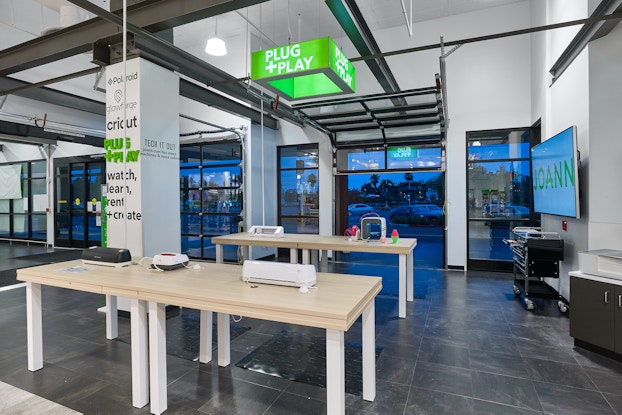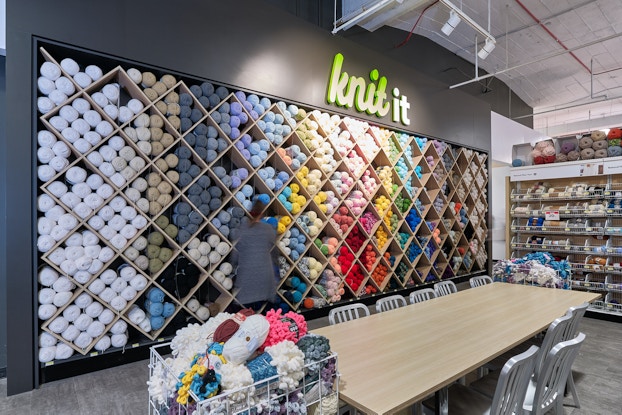
Three customer service tips for a post-pandemic shopping landscape:
- Have a process in place to regularly listen to customer feedback on their store experience.
- Find ways to save consumers time, such as sending a text message when an order is ready.
- Offer consumers myriad ways to solve their problems — via knowledgeable in-store sales associates or instructional videos on your website, to customer service solutions on social media channels.
This fall, Joann, a leading sewing, fabrics and crafts retailer with 853 stores in 49 states, began unveiling remodeled stores designed to reflect the new ways customers want to shop.
The reimagined stores give customers more hands-on experiences, such as demonstrations of the latest crafting and sewing tools, classes and spaces where crafters can rent time on specialized machines to complete projects. Joann also has added digital tools to make it easier for customers to get information about products, place online orders while at the store or collect curbside orders.
The retailer was getting ready to roll out its first group of reinvented stores when the pandemic hit. That delayed the effort, but also showed Joann executives the importance of creating stores that could pivot quickly to adapt to change.
Before creating the new store models, Joann first had to make sure they knew what their customers wanted, and how to give them what they wanted. Christopher DiTullio, chief customer officer and senior vice president at Joann, spoke with CO— about the top lessons learned while creating a new store experience.

Make sure you have a way to listen to customers
“We do a lot of research at Joann with our customers. It’s ongoing,” DiTullio said. “Have a process in place as a company where you’re continually seeking feedback from your customer on their shopping experience, whether that’s physical, digital shopping or the intersection of the two,” he said.
“As you’re having that dialogue with your customers, you’re going to understand what the real opportunities are,” he said.
Customers told Joann about what they didn’t like about the old stores, and at the remodeled stores, the company is continuing to solicit feedback and measure customer satisfaction.
[Read: The New Consumer: The Top Trends Shaping the Post-Pandemic Shopper]
Time is so critical for them. They’re so crunched for time. Anything that you can do as a retailer to remove friction in that customer engagement process that helps reduce time for the customer, they’re going to pay you back with their loyalty.Christopher DiTullio, chief customer officer, Joann
Customers want you to save them time
“Time is so critical for them. They’re so crunched for time,” DiTullio said. “Anything that you can do as a retailer to remove friction in that customer engagement process that helps reduce time for the customer, they’re going to pay you back with their loyalty,” he said.
With curbside service, Joann gets orders to customers’ cars within two minutes. It installed a “cut bar” in the stores where shoppers can get a text message notifying that their fabric order is ready to be measured and cut, eliminating the need to wait in line for fabric purchases.
[Read: Smarter Selling: The Five Tech Trends Reshaping Retail]
Customers want you to help them solve problems
“In our space, craft and sewing, people are buying components to make something,” DiTullio said. That means they frequently also need help with those projects – either in the store from a knowledgeable salesperson, or on the website with instructional videos, or on social media channels.
“The more you can solve a problem for a customer, the more loyalty you’ll gain from them,” he said.

Customer needs can change quickly, so plan for flexibility
“What we’ve learned over the course of the pandemic and in our new-format stores is the importance of being agile and flexible so you can pivot as customer behavior changes, because it has, rather significantly, over the past few years,” DiTullio said.
For example, he said, omnichannel has become critical to retail shopping experiences. “Customers expect now to be able to shop your website, shop your mobile app, place orders to pick up in store, pick up curbside. Having the flexibility to [offer] up those service options is how I believe you win in retail in the 2020s,” he said.
“And by having an ongoing conversation with your customers, you’ll begin to see what those needs are before it becomes critical.”
CO— aims to bring you inspiration from leading respected experts. However, before making any business decision, you should consult a professional who can advise you based on your individual situation.
Follow us on Instagram for more expert tips & business owners’ stories.
CO—is committed to helping you start, run and grow your small business. Learn more about the benefits of small business membership in the U.S. Chamber of Commerce, here.

Interested in a small business membership?
Find out how the U.S. Chamber of Commerce can help your company grow and thrive in today's rapidly-evolving business environment. Connect with our team to learn how a small business membership can benefit your bottom line and help you achieve your goals.







